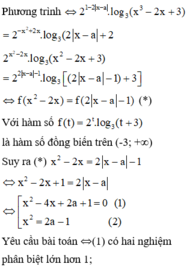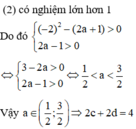Tìm giá trị tham số a để phương trình nhận t = 3 là nghiệm.
Hãy nhập câu hỏi của bạn vào đây, nếu là tài khoản VIP, bạn sẽ được ưu tiên trả lời.

a, \(\frac{1}{2}\left(x+1\right)\left(3-x\right)+x=3\)
\(\Leftrightarrow\frac{1}{2}\left(x+1\right)\left(3-x\right)-\left(3-x\right)=0\)
\(\Leftrightarrow\left(3-x\right)\left(\frac{x}{2}+\frac{1}{2}-1\right)=0\)
\(\Leftrightarrow\left(3-x\right)\frac{x-1}{2}=0\Leftrightarrow x=3;x=1\)
b, \(\left(2x+1\right)\left(1-x\right)+2x=2\)
\(\Leftrightarrow\left(2x+1\right)\left(1-x\right)-2\left(1-x\right)=0\)
\(\Leftrightarrow\left(2x-1\right)\left(1-x\right)=0\Leftrightarrow x=\frac{1}{2};x=1\)
c, Vì t = 3 là nghiệm của phương trình nên thay t = 3 vào phương trình trên ta được :
\(\Rightarrow\frac{2}{5}-3-a-3=2a\left(a+2\right)\Leftrightarrow\frac{2}{5}-6-a=2a\left(a+2\right)\)
\(\Leftrightarrow\frac{2-30-5a}{5}=\frac{10a\left(a+2\right)}{5}\)Khử mẫu :
\(\Rightarrow-28-5a=10a^2+20a\)
\(\Leftrightarrow-10a^2-25a-28=0\) tự làm nốt nhé !!!
d, \(\left(x-2\right)^2=\left(2x+3\right)^2\)
TH1 : \(x-2=2x+3\Leftrightarrow x=-5\)
TH2 : \(x-2=-2x-3\Leftrightarrow x=-\frac{1}{3}\)

Thay t = 3 vào phương trình, ta được:
\(1-a-3=2a\left(a+2\right)\)
\(\Leftrightarrow-2-a=2a^2+4a\)
\(\Leftrightarrow2a^2+5a+2=0\)
Ta có \(\Delta=5^2-4.2.2=9,\sqrt{\Delta}=3\)
\(\Rightarrow\orbr{\begin{cases}a=\frac{-5+3}{4}=\frac{-1}{2}\\a=\frac{-5-3}{4}=-2\end{cases}}\)

Bài 2:
a: \(\Leftrightarrow4x^2\left(ax-3\right)-\left(ax-3\right)=0\)
\(\Leftrightarrow\left(ax-3\right)\left(2x-1\right)\left(2x+1\right)=0\)
Trường hợp 1: a=0
=>(2x-1)(2x+1)=0
=>x=1/2 hoặc x=-1/2
Trường hợp 2: a<>0
\(\Leftrightarrow\left[{}\begin{matrix}x=\dfrac{1}{2}\\x=-\dfrac{1}{2}\\x=\dfrac{3}{a}\end{matrix}\right.\)
b: \(\Leftrightarrow a^2x^2\left(2x+5\right)-4\left(2x+5\right)=0\)
\(\Leftrightarrow\left(2x+5\right)\left(a^2x^2-4\right)=0\)
Trường hợp 1: a=0
Phương trình sẽ là 2x+5=0
hay x=-5/2
Trường hợp 2: a<>0
Phương trình sẽ là \(\left(2x+5\right)\left[\left(ax\right)^2-4\right]=0\)
\(\Leftrightarrow\left[{}\begin{matrix}x=-\dfrac{5}{2}\\x=-\dfrac{2}{a}\\x=\dfrac{2}{a}\end{matrix}\right.\)

a) Điều kiện để phương trình có hai nghiệm trái dấu là :
\(\left\{{}\begin{matrix}m\ne0\\\Delta phẩy>0\\x_1.x_2< 0\end{matrix}\right.\)
\(\Leftrightarrow\left\{{}\begin{matrix}m\ne0\\m^2+4m+4-m^2+3m>0\\\dfrac{m-3}{m}< 0\end{matrix}\right.\)
\(\Rightarrow0< m< 3\)
b) Để phương trình có 2 nghiệm phân biệt thì : \(\Delta\) phẩy > 0
\(\Rightarrow m< 4\)
Ta có : \(\dfrac{1}{x_1^2}+\dfrac{1}{x_2^2}=2\)
\(\Leftrightarrow x_1^2+x_2^2=2x_1^2.x_2^2\)
\(\Leftrightarrow\left(x_1+x_2\right)^2-2x_1.x_2=2x_1^2.x_2^2\)
Theo Vi-ét ta có : \(x_1+x_2=\dfrac{-2\left(m-2\right)}{m};x_1.x_2=\dfrac{m-3}{m}\)
\(\Rightarrow\dfrac{4\left(m-2\right)^2}{m^2}-2.\dfrac{m-3}{m}=2.\dfrac{\left(m-3\right)^2}{m^2}\)
\(\Leftrightarrow m=1\left(tm\right)\)
Vậy...........
a) \(mx^2+2\left(m-2\right)x+m-3=0\left(1\right)\)
Để \(\left(1\right)\) có hai nghiệm trái dấu \(\Leftrightarrow\left\{{}\begin{matrix}\Delta'=\left(m-2\right)^2-m\left(m-3\right)>0\\\dfrac{m-3}{m}< 0\end{matrix}\right.\)
\(\Leftrightarrow\left\{{}\begin{matrix}m^2-4m+4-m^2-3m>0\\0< m< 3\end{matrix}\right.\) \(\Leftrightarrow\left\{{}\begin{matrix}7m+4>0\\0< m< 3\end{matrix}\right.\)
\(\Leftrightarrow\left\{{}\begin{matrix}m>-\dfrac{4}{7}\\0< m< 3\end{matrix}\right.\) \(\Leftrightarrow0< m< 3\)
b) \(\dfrac{1}{x^2_1}+\dfrac{1}{x^2_2}=2\Leftrightarrow\dfrac{x^2_1+x_2^2}{x^2_1.x^2_2}=2\) \(\Leftrightarrow\dfrac{\left(x_1+x_2\right)^2-4x_1.x_2}{x^2_1.x^2_2}=2\)
\(\Leftrightarrow\left(\dfrac{x_1+x_2}{x_1.x_2}\right)^2-\dfrac{4}{x_1.x_2}=2\)
\(\Leftrightarrow\left(\dfrac{\dfrac{2\left(2-m\right)}{m}}{\dfrac{m-3}{m}}\right)^2-\dfrac{4}{\dfrac{m-3}{m}}=2\)
\(\Leftrightarrow\left(\dfrac{2\left(2-m\right)}{m-3}\right)^2-\dfrac{4m}{m-3}=2\)
\(\Leftrightarrow4\left(2-m\right)^2-4m\left(m-3\right)=2.\left(m-3\right)^2\)
\(\Leftrightarrow4\left(4-4m+m^2\right)-4m^2+12=2.\left(m^2-6m+9\right)\)
\(\Leftrightarrow16-16m+4m^2-4m^2+12=2m^2-12m+18\)
\(\Leftrightarrow2m^2+4m-10=0\)
\(\Leftrightarrow m^2+2m-5=0\)
\(\Leftrightarrow\left[{}\begin{matrix}m=-1+\sqrt[]{6}\\m=-1-\sqrt[]{6}\end{matrix}\right.\) \(\Leftrightarrow m=-1+\sqrt[]{6}\left(\Delta>0\Rightarrow m>-\dfrac{4}{7}\right)\)

a: Khi m=1 thì pt sẽ là: x+x-3=6x-6
=>6x-6=2x-3
=>4x=3
=>x=3/4
b: m^2x+m(x-3)=6(x-1)
=>x(m^2+m-6)=-6+3m=3m-6
=>x(m+3)(m-2)=3(m-2)
Để (1) có nghiệm duy nhất thì (m+3)(m-2)<>0
=>m<>-3 và m<>2
=>x=3/(m+3)
\(A=\dfrac{\left(\dfrac{3}{m+3}\right)^2+\dfrac{6}{m+3}+3}{\left(\dfrac{3}{m+3}\right)^2+2}\)
\(=\dfrac{9+6m+18+3m^2+18m+27}{\left(m+3\right)^2}:\dfrac{9+2m^2+12m+18}{\left(m+3\right)^2}\)
\(=\dfrac{3m^2+24m+54}{2m^2+12m+27}>=\dfrac{1}{2}\)
Dấu = xảy ra khi 6m^2+48m+108=2m^2+12m+27
=>4m^2+36m+81=0
=>m=-9/2

Câu 1:
1: Ta có: \(16\sqrt{9}-9\sqrt{16}\)
\(=16\cdot3-9\cdot4\)
\(=48-36=12\)
2:
a) Thay x=2 và y=8 vào hàm số \(y=a\cdot x^2\), ta được:
\(a\cdot2^2=8\)
\(\Leftrightarrow4a=8\)
hay a=2
Vậy: a=2


Tìm được a ∈ ( - 1 ; - 1 2 )